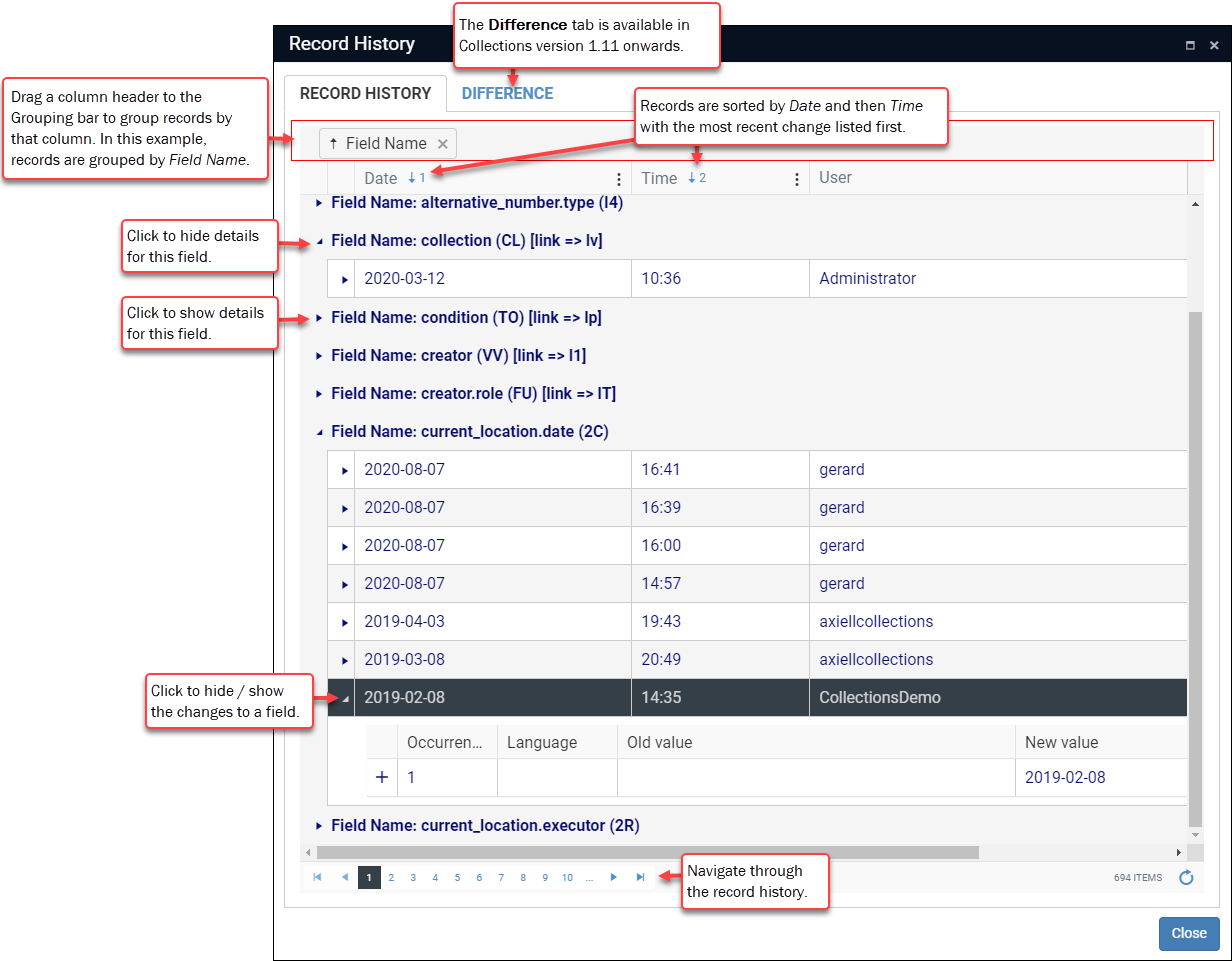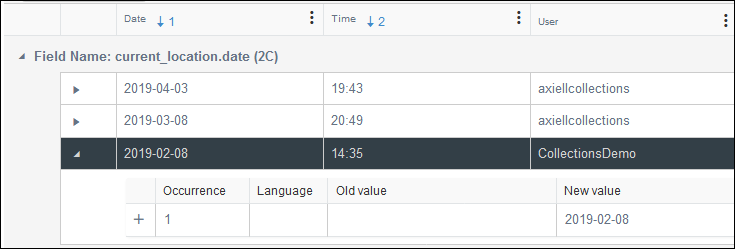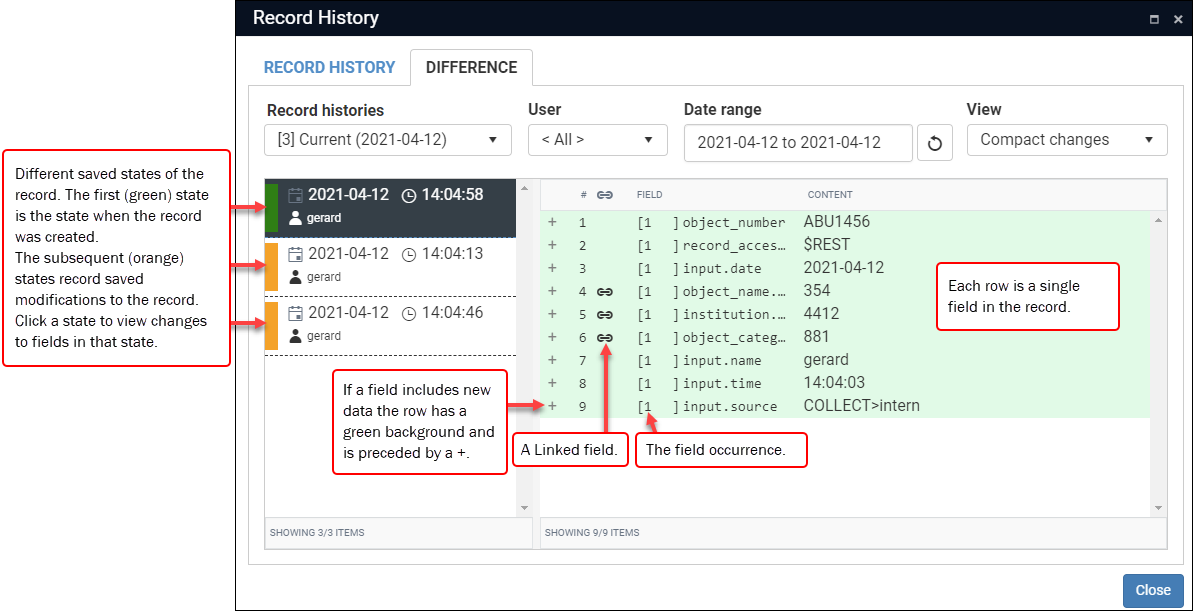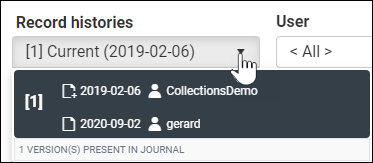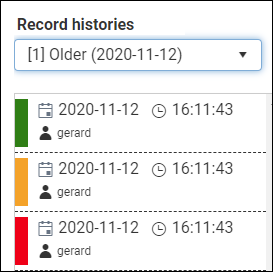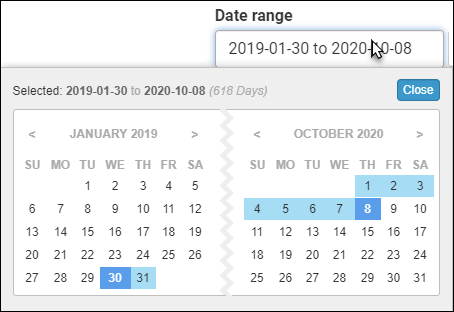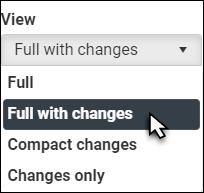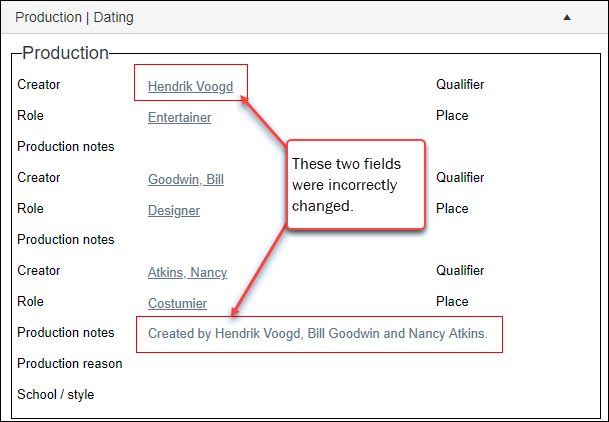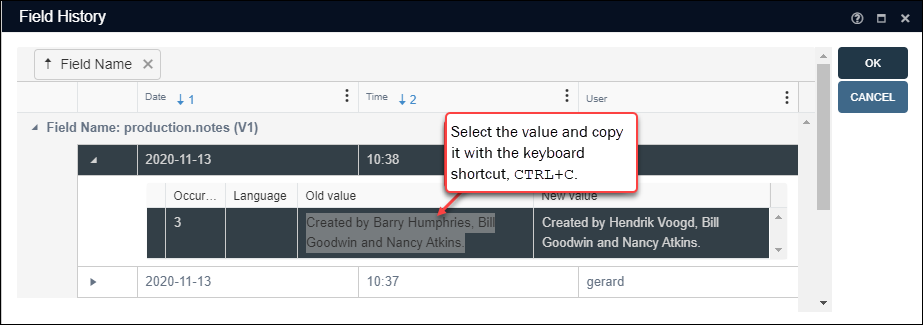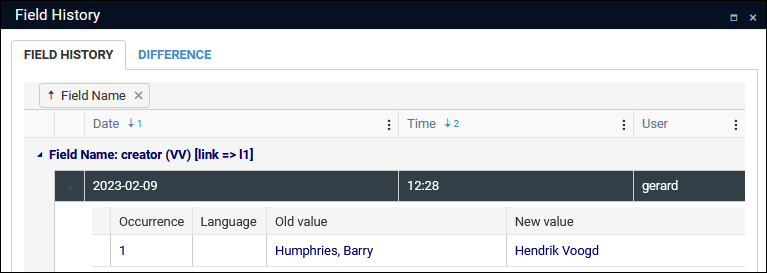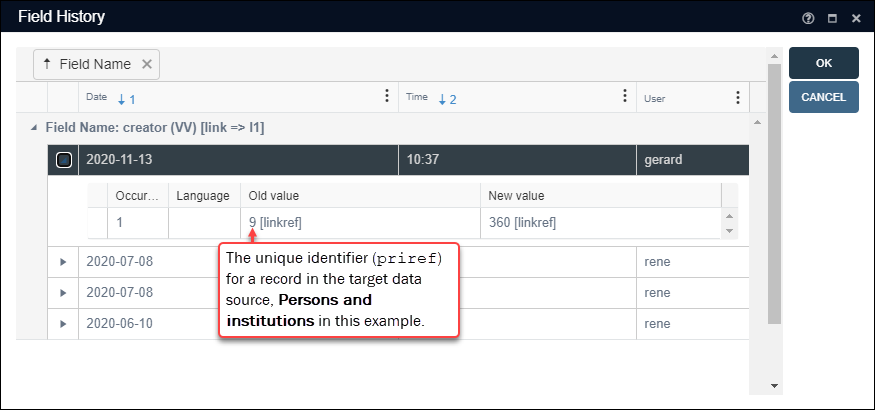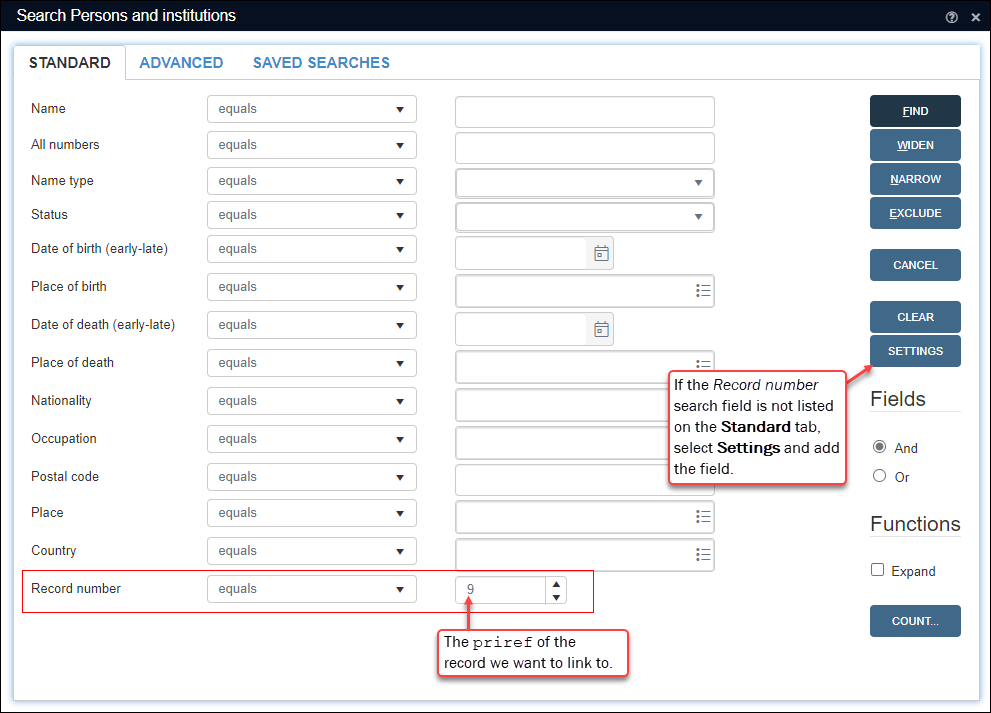View changes to a record and restore a field to an earlier value
Details about how to enable record history per data source can be found in the Axiell Designer Help.
Collections can be configured to maintain a history of changes to every field in a record. If it is then necessary to restore a field to an earlier value, authorized users can view the record history and restore the earlier value. When this functionality is available in your system and you are authorized to use it:
-
The Record history
 button will display in the Result set View toolbar.
button will display in the Result set View toolbar.Select the button to display the Record History box listing fields in the current record
 The record currently displayed in Record details View or highlighted (with a solid background) in Result set View or Gallery View for instance., the date and time of any changes to a field, the name of the user responsible for the change, and details of the old and new value(s).
The record currently displayed in Record details View or highlighted (with a solid background) in Result set View or Gallery View for instance., the date and time of any changes to a field, the name of the user responsible for the change, and details of the old and new value(s). -
When a field is right-clicked in Result set View or Record details View (in fact anywhere it is possible to edit a field) the context menu that pops up will include a History option.
This option provides the same details as the Record History box (described below) but for the selected field only.
 View the Field history for the current field
View the Field history for the current field
When viewing or editing record details in Result set View or Record details View, right-click a field to display a context menu; the menu has different options in each View, but both include a History option:
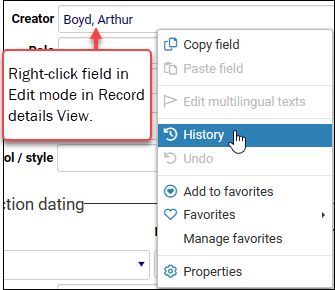
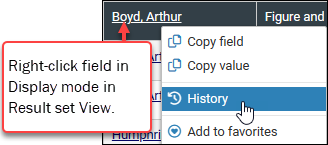
Select History to display the Field History box with audit details for the current field only, including the field's system name and tag, the date and time of any changes, the name of the user responsible for a change, and details of the old and new value(s):
In the Record History box we view the record history for the current :
To view the record history for the current record, select the Record history  button in the Result set View toolbar.
button in the Result set View toolbar.
The Record History box displays:
If your version of Collections is older than version 1.11, the Record History box will only include the Record History tab; otherwise it will also include the Difference tab:
Four columns of information display for all fields that hold or held data:
- Field Name - the field's system name and tag are shown.
- Date - the date of the change to the field.
- Time - the time of the change to the field.
- User - the user responsible for the change.
By default, records are grouped by Field Name (all changes made to a field are grouped together).
Note: Grouping is achieved by dragging a column header to the Grouping bar. You can find more details about using the Grouping bar to group records here.
Records are sorted by Date and then Time so that the most recent change is listed first.
To view the changes to a field:
- Click the arrow head beside a field name to show all changes to a field sorted by date and time.
- Click the arrow head beside a date / time to show details of the change to a field on that date / time.
Note: A history of all changes to fields is provided, including fields that are updated by the system rather than users.
Here we see that the current_location.date field has been changed three times. The row for the earliest date has been expanded:
Information shown for each field change:
| Element | Details | ||||||||
|---|---|---|---|---|---|---|---|---|---|
|
Date & Time
|
The date and time of a change. In this example, the first change to the field was made on 8 February 2019 at 2:35 pm. |
||||||||
|
User |
The user who made the change to the field. |
||||||||
|
|
The first cell in a row will hold:
|
||||||||
|
Occurrence |
A row will display for every occurrence If a field can hold multiple occurrences, creator for example, a history for each occurrence will be recorded:
|
||||||||
|
Language |
If a field is multilingual, the language code will be recorded for the data language selected when the value was saved, e.g. en-US for US English, sv-SE for Swedish. |
||||||||
|
Old value |
If the value in a field was changed on this date / time, the old value will show here. In the example above, we're viewing the first change to the current_location.date, so there is no old value. To restore a value, it is often only necessary to copy an old value and paste it. Restoring a Linked field |
||||||||
|
New value |
If this is the first time a value was added to the field, or an existing value was changed, the new value is shown here. |
The Difference tab, which is available in Collections versions 1.11 onwards, provides an alternative way to view the current and previous states of a record:
The tab comprises two panels, and four drop lists that are used to filter the information displayed:
|
Panel |
Details |
||||||||
|---|---|---|---|---|---|---|---|---|---|
|
The panel on the left lists each state of the record when it was last saved. In the example above, we see three states for the current record: the first (green) state is the state when the record was created. Two subsequent (orange) states identify saved modifications to the record. Details include:
Select a state in the left panel to view details about changes to fields in the right panel. Three states are possible:
|
|||||||||
|
When a state is selected in the left panel, details about changes to fields are shown in the right panel. Each row holds details about a single field:
Hover the cursor over a field name to see the field tag in a tooltip:
A combination of colour-coding and symbols indicate whether data is new, modified or deleted:
|
The four drop lists provide different filtering options:
|
Drop list |
|
|||||||||
|---|---|---|---|---|---|---|---|---|---|---|
|
Typically, the Record histories drop list only includes a single version of the record, the current version. The creation date and last edit date are shown, along with the user name of the user responsible for the record change:
However, under certain circumstances, other versions of the record may also display in the drop list:
When a record is deleted, its record number (priref
|
||||||||||
|
User |
If multiple users have edited the record, it is possible to view changes by <All> or a specific user:
|
|||||||||
|
Date range |
Click the Date range field to display a date picker and select two dates: only record states between these dates will be listed in the left pane:
Always select two dates (click the start and then the end date) and click Close to update the overview. Click the Return |
|||||||||
|
View |
Four View options are available:
|
|||||||||
|
Authorized users can restore an earlier value to a field:
In this example, two fields were incorrectly changed:
Restoring the value in Production notes is straightforward and we demonstrate that first. Depending on your version of Collections, restoring the value in a Linked field![]() A type of field used to link one record to another. A Linked field is a drop list of values (records that the field can link to). When a link is made, the field stores a reference to the linked record (a linkref)., Creator (creator (VV)) in this example, can be a little more involved. Details below.
A type of field used to link one record to another. A Linked field is a drop list of values (records that the field can link to). When a link is made, the field stores a reference to the linked record (a linkref)., Creator (creator (VV)) in this example, can be a little more involved. Details below.
We could use either the Record History or Field History box to restore these values to an earlier state. As we see above, the Record History box lists all changed fields in the current record: when restoring a field to an earlier value it is first necessary to locate the changed field in the Record History box. In this demonstration we use the Field History box as it provides all the details we need about the current field.
To restore an old value:
- Right-click a field, in this example Production notes (production.notes (V1)), and select History in the context menu:
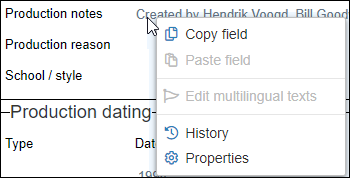
The Field History box displays.
-
Identify the correct value, select it and copy it with the keyboard shortcut, CTRL+C:
- Close the Field History box and open the record in Edit mode
 A record is either in Display mode (we view its details) or Edit mode (we add or edit its details). A record enters Edit mode as soon as we create a new record, copy a record in Record details View or edit an existing record. (e.g. select Edit
A record is either in Display mode (we view its details) or Edit mode (we add or edit its details). A record enters Edit mode as soon as we create a new record, copy a record in Record details View or edit an existing record. (e.g. select Edit  in the Record details View toolbar).
in the Record details View toolbar). - Paste (CTRL+V) the value into the relevant field:

- Save the record.
From Collections version 1.16 onwards, restoring the value in a Linked field![]() A type of field used to link one record to another. A Linked field is a drop list of values (records that the field can link to). When a link is made, the field stores a reference to the linked record (a linkref). is fairly straightforward (details below if your version of Collections is older):
A type of field used to link one record to another. A Linked field is a drop list of values (records that the field can link to). When a link is made, the field stores a reference to the linked record (a linkref). is fairly straightforward (details below if your version of Collections is older):
- Right-click a Linked field and select History in the context menu to display the Field History box.
In this example the Linked field is Creator (creator (VV)), which links a record in the Object catalogue (the primary data source
 A link is made from a record in one data source (primary) to a record in another data source (target). A data source could be both the primary and target data source in a linking relationship if one of its records links to another of its records.) to a record in Persons and institutions (the target data source):
A link is made from a record in one data source (primary) to a record in another data source (target). A data source could be both the primary and target data source in a linking relationship if one of its records links to another of its records.) to a record in Persons and institutions (the target data source): - Note the old value,
Humphries, Barryin this example. - Close the Field History box and open the record in Edit mode
 A record is either in Display mode (we view its details) or Edit mode (we add or edit its details). A record enters Edit mode as soon as we create a new record, copy a record in Record details View or edit an existing record. (e.g. select Edit
A record is either in Display mode (we view its details) or Edit mode (we add or edit its details). A record enters Edit mode as soon as we create a new record, copy a record in Record details View or edit an existing record. (e.g. select Edit  in the Record details View toolbar).
in the Record details View toolbar). -
Update the link:

- Save the record to restore the link.
If your version of Collections is older than 1.16, restoring the value in a Linked field is a little more involved:
Restoring the value in a Linked field is a little more involved as the field history only records the unique identifier (priref![]() A record's unique identifier (aka Record number). The Record number field is found on the Management details (or Notes and description) panel in Collections version 5.0 onwards. Alternatively, add the priref column to Result set View. The field tag for the priref field is %0.) for the linked record; to restore a link to a record, we first use the priref to identify the record and then we restore the link to it:
A record's unique identifier (aka Record number). The Record number field is found on the Management details (or Notes and description) panel in Collections version 5.0 onwards. Alternatively, add the priref column to Result set View. The field tag for the priref field is %0.) for the linked record; to restore a link to a record, we first use the priref to identify the record and then we restore the link to it:
To restore a link:
-
Right-click a Linked field and select History in the context menu to display the Field History box.
In this example the Linked field is Creator (creator (VV)), which links a record in the Object catalogue (the primary data source
 A link is made from a record in one data source (primary) to a record in another data source (target). A data source could be both the primary and target data source in a linking relationship if one of its records links to another of its records.) to a record in Persons and institutions (the target data source):
A link is made from a record in one data source (primary) to a record in another data source (target). A data source could be both the primary and target data source in a linking relationship if one of its records links to another of its records.) to a record in Persons and institutions (the target data source):Tip: See Linking records: an overview for all you need to know about linking records and linking terminology.
- Identify the old value and note the unique identifier (priref) for the record you want to restore the link to.
- Search the target data source
 A link is made from a record in one data source (primary) to a record in another data source (target). A data source could be both the primary and target data source in a linking relationship if one of its records links to another of its records. for the priref.
A link is made from a record in one data source (primary) to a record in another data source (target). A data source could be both the primary and target data source in a linking relationship if one of its records links to another of its records. for the priref.Tip: Full details about performing a search can be found here.
In this case we are searching for the creator of an item, so we search Persons and institutions.
You can perform your search on the Standard tab by searching the Record number field for the priref (details about how to add a search field to the Standard tab here):
Alternatively, specify a search statement on the Advanced search tab:

This will identify the record to link to. In this example, the record with a priref of
9in Persons and institutions is for Barry Humphries. -
Now that you have identified the record to link to, return to the primary record
 A link is made from one record (the primary) to another (the target). and update the link:
A link is made from one record (the primary) to another (the target). and update the link:
- Save the record to restore the link.

